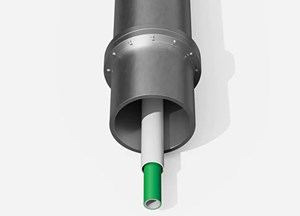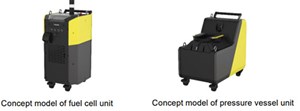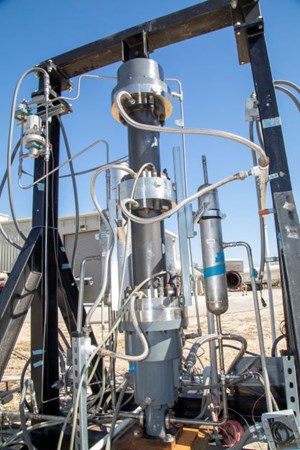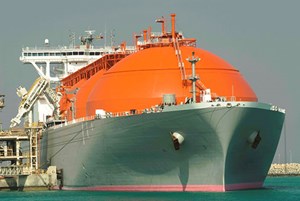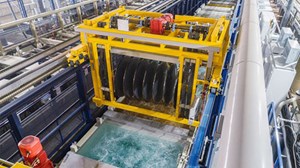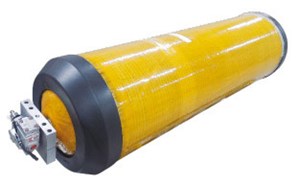Articles
H2Tech: Tech Spotlight
T. CAMPBELL, Managing Editor
H2 EQUIPMENT
Aerodyne unveils analyzer to track and reduce H2 leaks
Aerodyne Research and the U.S.-based Environmental Defense Fund have unveiled a new instrument for operators to track and reduce the amount of hydrogen (H2) escaping from their facilities. The two teamed up to demonstrate the efficacy of a H2 analyzer to quantify H2 emissions at a facility scale for the first time.
The analyzer uses laser spectroscopy to detect and quantify H2 concentrations as small as 10 parts per billion, a significant improvement in the capabilities of such systems that are designed to see very high concentrations that pose an immediate safety risk. The analyzer was tested at Colorado State University’s advanced METEC engineering facility and delivered high-precision measurements every second with 98% accuracy.
H2C releases safety pipe for gaseous H2 distribution
H2C’s patented Pipe-within-a-PipeTM technology provides mid- and last-mile distribution of pure gaseous H2 using existing rights of way, mitigating leakage risks while avoiding stranded pipeline assets. The pipe system employs an outer, jacketed safety pipe, inert sweep gas, sensors and automated real-time response systems that monitor and control any potentially unsafe H2 leakage from the inner H2 distribution line.
The technology uses existing infrastructure to avoid stranded assets, reducing expensive new pipeline build-out and eliminating costly intermittent truck deliveries. In addition, it mobilizes 99.9% H2 purity levels required to serve the mobility (fuel cell grade H2) and specialized large-scale industrial markets. Other rights-of-way that can be used include water pipes, sewer lines, storm drains, and utility and broadband corridors.
The safety pipe supports lower installation and freight costs than the conventional steel solution. The cost per mile of the pipe is approximately $600,000 compared to approximately $1.3 MM for its steel counterpart.
Emerson BM6X Series Slam-Shut valve receives certification for use in H2 applications
Emerson has received approval from Bureau Veritas Italia for its BM6X Series Slam-Shut valve for applications with up to 100% H2 and pressures up to 100 bar. The certification was achieved due to the commitment of Emerson and Bureau Veritas Italia to ensure suitable products are available for use in new H2 infrastructure. The certification granted to the Emerson BM6X Series Slam-Shut valve confirms material suitability based on internal and external seal tests performed at the Emerson production plant in Castel Maggiore, Bologna, Italy.
The valve has multiple applications throughout gas transmission networks, regulating stations and end-use infrastructure. For example, natural gas transmission and distribution companies can blend H2 into their distribution systems, reducing emissions when the blended mixture of H2 and natural gas is burned in homes for cooking, heating and other uses. Additionally, industrial end users can reduce emissions by using a mix of H2 and natural gas as fuel for turbines used for power generation.
Teijin develops portable fuel cell and pressure vessel units to promote clean H2 energy use
Teijin Ltd. has developed a compact, lightweight and highly portable fuel cell unit and pressure vessel unit that supplies H2 fuel from three lightweight cylinders. The new solution for integrated fuel cell operation and easy fuel supply is expected to help expand the range and scope of fuel cell use.
The fuel cell unit is a portable generator that conveniently integrates the equipment necessary for fuel cell operation. Its compact and lightweight design incorporates the new IE-LIFTTM 1T fuel cell developed by British manufacturer Intelligent Energy. A large-capacity battery ensures about 1 hr of continuous operation at the rated output if the H2 supply is temporarily depleted or the fuel cell fails.
A built-in communication terminal enables the remaining H2 and the unit's operating status to be monitored remotely via a mobile device, reducing the burden of monitoring critical information and the risk of encountering potential problems. The unit also has an internal system to visualize the amount of carbon dioxide (CO2) emissions eliminated compared to a fossil-fuel generator. The fuel cell, which measures 450 (W) x 570 (D) x 910 (H) mm and weighs about 60 kg, is rated for 700 W−800 W continuous power and 1,500 W maximum power.
The new pressure vessel unit is a portable H2-fuel supply device equipped with three lightweight, corrosion-resistant composite pressure cylinders. In addition to reducing the overall weight when transporting H2 fuel under high pressure, the cylinders feature an inner liner made of seamless gas-tight aluminum alloy wrapped in high-strength fibers in a multilayer structure impregnated with epoxy resin. In the unlikely event of cylinder failure due to overpressure, the liner will begin to leak gas rather than rupture.
The units will be used for the first time in June 2023 in a demonstration with Tokyu Construction, which is participating in a major redevelopment of the Shibuya Station area in Tokyo, Japan, where the demonstration will occur. After verifying performance during the demonstration, Teijin expects to begin selling commercial versions of the fuel cell and pressure vessel in Japan around the spring of 2024.
SwRI develops H2 compressors for FCEV refueling stations
A new H2 compressor developed at Southwest Research Institute (SwRI) can improve the efficiency and reliability of H2 compression used in fueling fuel cell electric vehicles (FCEVs). The SwRI-developed linear motor-driven reciprocating compressor (LMRC) is designed to compress H2 as a fuel source for FCEVs and other H2-powered vehicles. Unlike most H2 compressors, SwRI’s LMRC is hermetically sealed and has a linear motor design that increases efficiency and reliability.
A key challenge for H2 compression is H2’s small particle size, which increases the potential for leaks as the gas flows through equipment. The novel LMRC features an airtight compressor, hermetically sealed, using a combination of SwRI-developed solutions. Coatings protect magnets from H2 incursion and embrittlement, while improved valve designs minimize leaks. It also utilizes a ceramic piston to minimize heat expansion and lower stress on its seal.
Most H2 compressors require oil-free mechanisms to avoid contaminants in the H2 gas. Unlike most reciprocating compressors, which have motors that repeatedly move in the same motion and require lubrication for maintenance, the LMRC’s linear motor can move the piston in a user-defined motion pattern, is mounted for vertical motion and has a unique dynamic seal design. As a result, the compressor’s seals and bearings experience less friction, negating the need for traditional lubrication. It can also be used in various compression applications to avoid gas leaking into the atmosphere, such as hazardous or flare gas recovery applications.
H2 PRODUCTION
Air Liquide constructs industrial-scale cracking technology to convert ammonia into H2
Air Liquide has announced the construction of an industrial-scale ammonia cracking pilot plant in the port of Antwerp, Belgium. When transformed into ammonia, H2 can be easily transported over long distances. Using innovative technology, this plant will make it possible to convert—with an optimized carbon footprint—ammonia into H2.
Ammonia—a molecule made of H2 and nitrogen—can be used as an energy carrier and can be produced with a low-carbon footprint from H2 in geographies with abundant renewable energy sources such as sun, water and wind. A global supply chain infrastructure is already in place for large-scale production, transportation and utilization to serve various industries. This allows regions with abundant renewable energy to export ammonia to end users around the globe, where it can be converted back to H2 to contribute to the decarbonization of industry and mobility.
The innovative pilot plant, which combines a novel efficient process with Air Liquide’s proprietary technologies, is planned to be operational in 2024. The Flemish Government, through the Flemish Agency for Innovation and Entrepreneurship, has confirmed financial support for the project.
Graforce introduces methane electrolysis to produce CO2-free H2 from LNG
Graforce will introduce methane electrolysis (plasmalysis)—a new technology that converts liquified natural gas (LNG) into H2. This allows large gas users to switch to clean-burning H2 without changing their energy supplier or transport method.
In the modular plasmalysis plants, a high-frequency plasma field—generated by renewable electricity—splits hydrocarbons such as methane into their molecular components: H2 and solid carbon. Compared to water electrolysis, plasmalysis requires only one-fifth of the energy to produce the same amount of H2. A 20-megawatt (MW) plant can convert about 70,000 metric tpy of LNG into H2 and save about 200,000 metric t of CO2. The H2 can be used for emissions-free electricity and heat generation or in the chemical industry.
Sunfire launches serial production of alkaline electrolyzers
Sunfire is now one of the first companies to start series production of electrolyzers. To this end, the Dresden-based manufacturer is automating its most important production step: electroplating. Electrolysis cells are metal-coated in electroplating lines. This step is crucial for Sunfire's electrolyzers' efficiency, robustness and durability and, therefore, differentiates the company from other suppliers.
Sunfire officially inaugurated an expansion of the proven electroplating line. In parallel, a state-of-the-art, fully automated 500-MW plant is already in preparation, which will start operation as early as this year.
H2 APPLICATIONS INNOVATIONS
Nuvera launches fuel cell stationary power generator
Nuvera Fuel Cells has announced the commercial availability of the 360-kilowatt (kW) and 470-kW Nuvera G-Series fuel cell power generators, a modular zero-emissions power solution for commercial and industrial applications including data centers, electric vehicles, backup power and microgrids.
Nuvera G-Series power generators operate on H2 and deliver three-phase volts of alternating current power in a containerized package. H2 produced from excess renewable power such as solar, wind or hydro can be used to store electricity effectively. The H2 can then be conveyed to the power generator or fed to the electrical grid to meet onsite power demands. When the grid is down, the system can provide back-up power for critical operations.
The generator features remote monitoring for maximizing up-time, day/night energy use, and power output that can be extended to a MW scale. Comprised of multiple Nuvera E-Series fuel cell engines, uptime is afforded by system redundancy. The generator can provide up to 85% of its maximum power while allowing one of its modules to be serviced.
DNV awards Approval in Principle to HAV for containerized H2 system for ships
HAV Hydrogen has unveiled details of the system that received Approval in Principle (AiP) from DNV. The AiP is an important milestone for HAV Hydrogen in bringing the new zero-emissions pod system onto the market.
The zero-emissions pod system is a turnkey, standalone power pod where all support and safety systems and electrical power management are included. By using 200-kW H2 fuel cells, the system is flexible and can easily provide 1,000 kW within the footprint of a standard 20 container. Multi-MW energy systems will also be available by combining multiple containers, using larger modules or dedicated space below the deck.
The installed effect can be used for the main propulsion systems or additional power supply on board the vessel to comply with green operation standards. The output effect will be dimensioned to provide optimal zero-emissions power in desired operating situations, sailing patterns and vessel types. The system is designed for operation in air temperatures between –20°C and 35°C and seawater temperatures from 0°C–32°C.
Toyoda Gosei launches large high-pressure H2 tank for commercial vehicles
Toyoda Gosei has launched a large high-pressure H2 tank. The need for these large tanks is expected to grow for use in fuel cell trucks that run on H2. The new tanks are used in the mass-market light-duty fuel cell electric trucks brought to the market by Commercial Japan Partnership Technologies, backed by Toyota Motor and Isuzu Motors.
These newly-developed large tanks can be filled with about eight times as much H2 as the passenger fuel cell vehicle tanks Toyoda Gosei produces for the Toyota Mirai (the second-generation model), installed in the vehicle’s rear.

